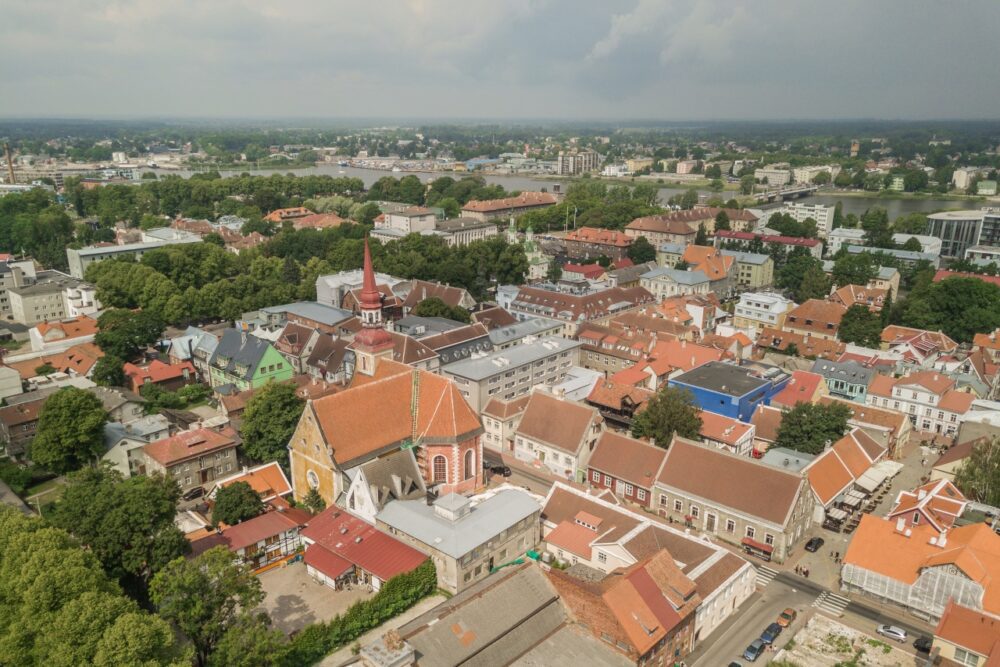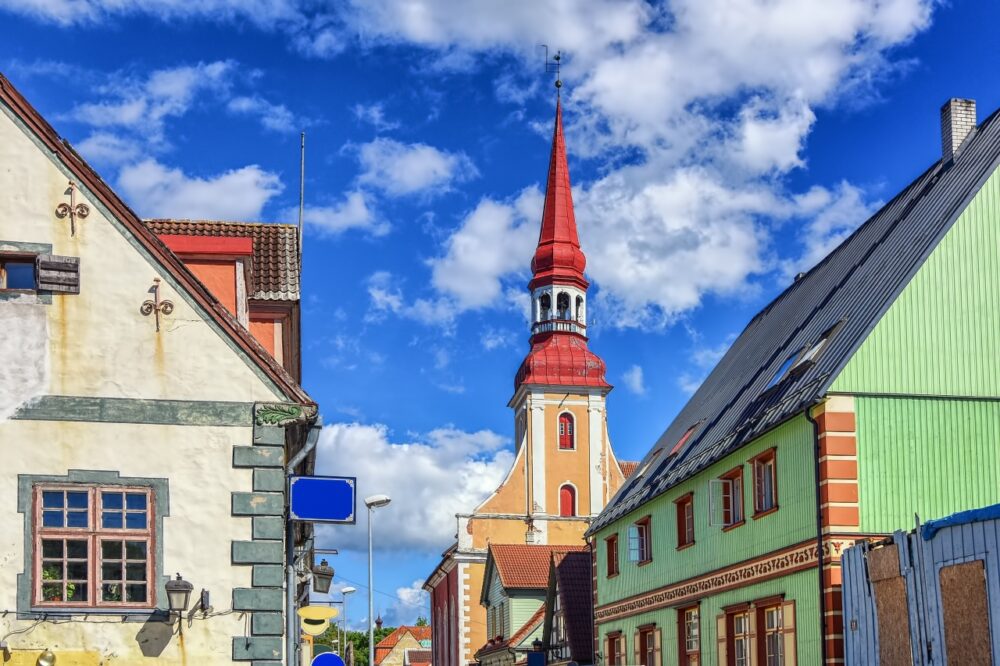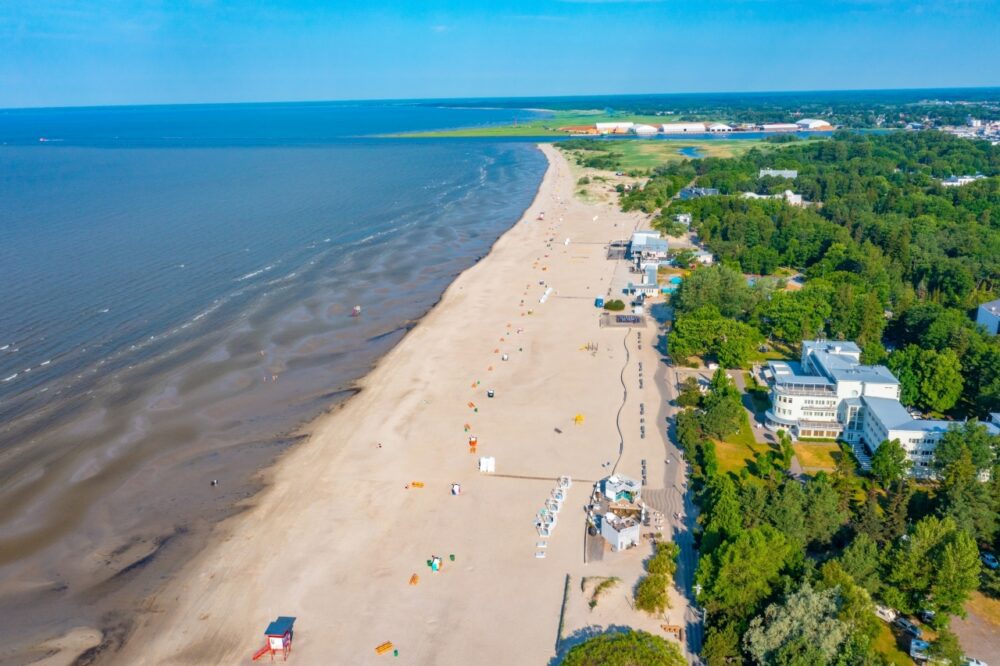
Is Pärnu worth visiting? Absolutely! The first time I set foot in Pärnu, Estonia’s summer capital, I was taken in by its laid-back vibe and beautiful sandy beaches. Walking along the seaside promenade, with the gentle breeze and the sound of waves, it was easy to see why this charming town is a favourite getaway for both locals and travellers alike.
Located on the western coast of Estonia, Pärnu is known for its stunning coastline, historic spa culture, and vibrant summer scene. But this town is more than just a beach destination. It’s home to a picturesque Old Town, relaxing parks, and plenty of cosy cafés and restaurants. Whether you’re soaking up the sun, exploring the elegant 19th-century villas, or unwinding in one of the town’s renowned spas, Pärnu offers a perfect mix of relaxation and charm. But is Pärnu worth visiting for you?
In this blog post, we’ll explore the top 10 reasons why Pärnu should be on your travel list, from its seaside appeal to its cultural highlights. Plus, we’ll share travel tips to help you plan the perfect trip. Keep reading to find out why Pärnu is the ideal destination for a rejuvenating getaway.
Table of Contents
Pros – Reasons You Should Visit Pärnu
1. A Beautiful Coastal Town with a Relaxed Atmosphere

Pärnu is Estonia’s most famous seaside resort, known for its wide sandy beaches, charming old town, and peaceful atmosphere. Unlike the capital, Tallinn, which has a busier, more urban feel, Pärnu is a place where people come to unwind and enjoy the slower pace of life. The town’s mix of historic architecture, scenic waterfront, and green parks makes it an ideal destination for those looking for both relaxation and culture.
One of the things I loved about Pärnu was how easy it was to explore on foot. The Rüütli Street, the town’s main pedestrian street, is lined with colourful wooden houses, small cafés, and boutique shops. Walking along it, I felt like I had stepped back in time, especially when passing by old buildings like the Red Tower, one of the last remaining parts of the medieval fortifications. The whole town has a welcoming and laid-back vibe, making it the perfect place to escape the stress of everyday life.
2. Stunning Beaches with Soft White Sand

Pärnu is home to one of the best beaches in the Baltic region, with soft, golden sand and shallow waters that make it ideal for swimming. Unlike the rocky coastlines found in some parts of Estonia, Pärnu’s beach stretches for kilometres, offering plenty of space to relax, sunbathe, or take a peaceful walk along the shore.
I visited the beach in the early evening, just as the sun was setting, and the view was breathtaking. The sky turned shades of orange and pink, reflecting off the calm waters of the Pärnu Bay. Families, couples, and solo travellers all gathered along the shore, either enjoying a swim or simply sitting on the sand, watching the sunset. The beach is well-maintained, with clean facilities, beachside cafés, and areas for beach volleyball and water sports. Even in the peak summer months, it never felt overcrowded, which made it a far more relaxing experience compared to some of the busier seaside destinations in Europe.
3. A Top Destination for Spas and Wellness
Pärnu is often called the spa capital of Estonia, and for good reason. The town has a long tradition of wellness tourism, with numerous spa hotels, wellness centres, and health retreats offering everything from traditional mud baths to modern luxury treatments. Whether you’re looking for a short massage or a full spa weekend, there are plenty of options to choose from.
I decided to try one of the town’s famous mud treatments, which use mineral-rich mud from the local area to help with relaxation and skin health. The experience was surprisingly soothing, and after just an hour, I felt completely refreshed. Many of the spas in Pärnu also offer saunas, hydrotherapy pools, and herbal baths, making it a great place to unwind. Even if you’re not staying in a spa hotel, most places allow visitors to book treatments for a few hours, making it easy to enjoy Pärnu’s wellness scene without a long commitment.
4. A Rich Cultural Scene with Festivals and Events
Despite its small size, Pärnu has a vibrant cultural scene, with festivals, concerts, and art exhibitions held throughout the year. From classical music performances to modern film screenings, the town offers something for every cultural interest, making it a great place to visit beyond just the beach.
One of the highlights of my visit was the Pärnu Film Festival, Estonia’s oldest international film festival, which screens independent and documentary films from around the world. The atmosphere was lively, with film lovers gathering in local cinemas and outdoor venues to watch unique productions. In the summer, the Pärnu Music Festival brings classical music to the town, with concerts held in beautiful historic settings. Even outside of festival season, the town’s Museum of New Art showcases a fascinating collection of contemporary Estonian artwork. If you enjoy cultural activities alongside your beach time, Pärnu offers a great mix of both.
5. A Great Destination for Outdoor Activities and Nature Lovers
Pärnu is surrounded by beautiful natural landscapes, making it a fantastic destination for outdoor enthusiasts. Whether you enjoy cycling, hiking, birdwatching, or kayaking, there are plenty of opportunities to explore the region’s stunning scenery. The nearby Soomaa National Park, just a short drive from the town, is one of Estonia’s most famous natural areas, known for its forests, wetlands, and unique “fifth season” floods in spring.
I took a bike ride along the Pärnu River, following peaceful cycling paths that passed through green parks and quiet countryside. The fresh sea air and lack of heavy traffic made the ride incredibly enjoyable. For those who prefer walking, the Valgeranna Nature Trail, located just outside the town, offers a scenic route through pine forests and along the coast. If you enjoy outdoor adventures, Pärnu provides a great balance between relaxing beach life and active exploration.
6. Delicious Local Cuisine with Fresh Seafood and Traditional Estonian Dishes
Pärnu has a fantastic food scene, with a mix of traditional Estonian cuisine and fresh Baltic seafood. Many of the restaurants in town focus on local, seasonal ingredients, offering simple yet flavourful dishes that highlight the region’s culinary heritage. Whether you prefer fine dining or casual seaside cafés, there are plenty of excellent food options to explore.
One of my favourite meals was a dish called räim (Baltic herring), a small, flavourful fish that is a staple of Estonian coastal cuisine. Served with potatoes and a light dill sauce, it was both fresh and satisfying. Another highlight was kama, a traditional Estonian dessert made from roasted grains, mixed with yoghurt or cream. It had a unique, slightly nutty taste that was unlike anything I had tried before. There are also plenty of modern restaurants serving international cuisine, so even if you’re not a fan of seafood or traditional dishes, there are lots of options to choose from.
7. A Family-Friendly Destination with Plenty of Activities for All Ages
Pärnu is an ideal destination for families, with plenty of activities and attractions designed for visitors of all ages. The town has a friendly, safe atmosphere, making it a stress-free place to travel with children. In addition to the beach, there are playgrounds, water parks, and interactive museums that provide entertainment for younger visitors.
One of the best family attractions is Tervise Paradiis, a water park with slides, pools, and saunas that’s perfect for both kids and adults. I also visited the Pärnu Museum, which offers an engaging look at the town’s history through interactive exhibits and artefacts. Families can also enjoy boat trips along the Pärnu River, which provide a relaxing way to see the town from a different perspective. Whether you’re travelling with children or simply looking for a destination that offers a welcoming and safe environment, Pärnu is a fantastic choice.
Cons – Things to Consider When Visiting Pärnu
1. The Weather Can Be Unpredictable and the Summer Season Is Short
Pärnu is known as Estonia’s summer capital, but its warm season is surprisingly short. While July and August bring pleasant temperatures and long daylight hours, the weather can still be unpredictable, with occasional rain showers and sudden temperature drops. Outside of summer, the town becomes much quieter, and the beach loses its appeal as the cold Baltic winds set in. Winters can be particularly harsh, with freezing temperatures and heavy snowfall, making it less attractive for visitors who prefer a warm, sunny getaway.
I visited Pärnu in late June, hoping for clear skies and warm weather, but instead, I experienced a mix of sunshine, chilly winds, and occasional drizzle. Even on a bright day, the sea temperature remained quite cool, making swimming less enjoyable than I had expected. Locals told me that the best time to visit is mid-July, when the weather is at its most reliable, but even then, there’s no guarantee of completely dry and warm conditions. If you’re planning a trip, it’s a good idea to check the forecast in advance and bring a mix of clothing for different temperatures.
2. Limited Activities Outside of the Summer Season
Pärnu thrives in summer when its beach, outdoor cafés, and festivals bring the town to life. However, outside of the peak months, many of the seasonal attractions, including beachfront restaurants, water sports, and some entertainment venues, close down or operate on reduced schedules. This means that visitors arriving in spring, autumn, or winter may find the town much quieter, with fewer things to do beyond indoor activities like spas and museums.
I visited in early September, just after the main tourist season, and noticed that many of the lively beachfront bars had already shut down for the year. The streets were noticeably quieter, and some of the local businesses had adjusted their opening hours to reflect the drop in visitors. While I still enjoyed the town’s peaceful atmosphere and wellness facilities, it lacked the energy and vibrancy that make it so appealing in summer. If you’re looking for a lively seaside experience, it’s best to visit between mid-June and August, when everything is open and the town is at its most active.
3. Public Transport is Limited, and a Car Is Often Necessary
Pärnu is a compact town that is easy to explore on foot, but if you want to visit nearby attractions, national parks, or other parts of the region, public transport options are quite limited. While there are buses connecting Pärnu to other Estonian cities like Tallinn and Tartu, local transport within the area can be infrequent and not always convenient for visitors. Taxis and ride-sharing services are available, but they can be expensive, especially for longer journeys.
I found this particularly challenging when trying to visit Soomaa National Park, a stunning nature reserve just outside Pärnu. While there are occasional tour operators offering guided trips, public transport to the park is almost non-existent, making a rental car the most practical option. Similarly, if you want to explore the Valgeranna beach area or other coastal spots outside the main town, having your own vehicle makes a huge difference. If you plan to stay in Pärnu for more than a couple of days and want to explore beyond the town itself, renting a car is highly recommended to avoid relying on limited transport options.
4. Dining and Accommodation Can Be Expensive in Peak Season
While Estonia is generally considered an affordable destination, prices in Pärnu can rise significantly during the summer months. As the town’s popularity grows, so do the costs of hotels, guesthouses, and restaurant meals, particularly in the most touristy areas near the beach and old town. Budget travellers may find it difficult to secure reasonably priced accommodation, especially if they don’t book well in advance.
I noticed this first-hand when searching for a hotel in July. Many of the centrally located options were either fully booked or charging rates that were much higher than in other Estonian towns. Restaurants near the waterfront also had noticeably higher prices compared to those slightly further from the main tourist areas. While there are ways to save money—such as dining at local markets, choosing guesthouses instead of hotels, or visiting outside of peak season—those on a tight budget might find that Pärnu is not as cheap as they expected. If you want to visit during the best weather but avoid high prices, planning and booking early is essential.
When to Visit Pärnu
The best time to visit Pärnu is during the summer months (June to August), when Estonia’s “Summer Capital” comes to life with warm weather, lively beaches, and a calendar full of open-air concerts and festivals. The city’s beach stretches along the Baltic Sea, making it a favourite with locals and tourists for swimming, sunbathing, and beach sports. Late spring (May) and early autumn (September) are quieter, with milder temperatures and fewer crowds, offering a more relaxed pace to explore the parks, spas, and historic centre. Winter in Pärnu is peaceful and tranquil, and the city’s renowned spas and cosy cafes make it a perfect place for a quiet retreat.
How to Get to Pärnu
The closest major airport to Pärnu is Tallinn Airport (TLL), which is about 130 kilometres north of the city and has regular flights from across Europe with airlines like Finnair, Lufthansa, and Ryanair. From Tallinn, Pärnu is easily accessible by bus, with Lux Express and Ecolines offering comfortable services that take about two hours. The Elron train network also has routes connecting Tallinn to Pärnu, with a scenic journey through the Estonian countryside. For those driving from Riga, Latvia, Pärnu is around two hours away by car, making it a convenient stop on a Baltic road trip.
Where to Stay in Pärnu
Pärnu has a range of accommodation options to suit all preferences, from beachfront luxury to cosy budget spots:
- Luxury: Beach Area – Close to the sea and scenic parks, Pärnu’s beachfront area offers some of the best hotels. Hedon Spa & Hotel and Estonia Resort Hotel & Spa provide high-end comfort with spa facilities, ideal for those seeking relaxation and easy beach access.
- Mid-range: Historic Centre – Near Pärnu’s Old Town and the main shopping streets, this area offers convenience and charm. Consider Villa Wesset or Parnu Hotel for comfortable stays close to cultural sights and restaurants.
- Budget: Mai – This residential area a bit further from the centre offers budget-friendly options within easy reach of Pärnu’s main attractions by bus or bike. Hostel Louna and Alex Maja offer affordable stays with a local feel.
Getting Around Pärnu
Pärnu is a compact city, and walking is often the best way to explore its Old Town, parks, and beachfront areas. For longer distances, the Pärnu City Transport bus network is efficient and affordable, with tickets available for single rides or as day passes. Pärnu is also a bike-friendly city, with rental shops and designated bike paths making it easy to explore on two wheels—ideal for heading to the beach or cruising through town. For a unique experience, try a boat ride on the Pärnu River, which offers scenic views of the city from the water.
How Long to Spend in Pärnu
Two to three days is ideal for Pärnu, giving you enough time to enjoy the beach, explore the charming Old Town, and relax in one of the city’s renowned spas. This timeframe also allows for sampling the local cuisine, strolling through the parks, and perhaps even catching a concert or festival if you’re visiting in summer. With an extra day, consider a nature excursion to the nearby Soomaa National Park, where you can hike, canoe, or experience the traditional “fifth season” flooding in spring. Pärnu’s easygoing vibe makes it a perfect place for both a quick retreat and a longer, relaxed stay.
Conclusion
So, is Pärnu worth visiting? Definitely! With its beautiful beaches, relaxing spas, and welcoming atmosphere, Pärnu is a fantastic choice for anyone looking to unwind. Highlights like the charming Old Town, the lively promenade, and its rich spa culture make it a top destination in Estonia. While it’s quieter in the off-season, this slower pace is part of its charm. If you’re ready to experience Estonia’s serene seaside gem, start planning your trip to Pärnu today—you’ll leave feeling refreshed and inspired!
